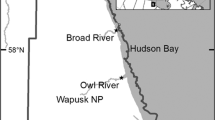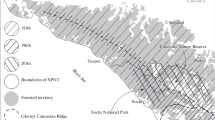Abstract
Human–bear interactions near the town of Churchill, Manitoba occur annually because the Western Hudson Bay polar bear population spends 4–5 months on-land each year when the sea ice melts completely. Significant changes have occurred in the Hudson Bay ecosystem and in the bear population as a result of climate warming; however, how these changes may have influenced human–bear interactions near Churchill is unclear. This study examined the temporal and spatial patterns of 1,487 problem bears captured in the Churchill area from 1970 to 2004. We also examined the relationship between problem bears and environmental variables as well as the Nunavut harvest. The number of individual problem bears caught near Churchill varied from 10 to 90 individuals per year and increased over time. Subadult males comprised 39%, subadult females 23%, adult males 18%, females with young 14%, and solitary females 6% of captures. Bears that became problem individuals were in closer proximity to the Churchill area. Nutritional stress and a northward shift in the distribution of the bears that spend the summer on-land in northeastern Manitoba may account for the increase in problem bear numbers. The date of sea ice freeze-up, which is getting progressively later, was the best predictor explaining the annual variation in the occurrence of problem bears. These results provide an understanding of how a warming climate may directly impact polar bear behaviour. This information may allow wildlife managers to predict relative levels of human–bear interactions and thereby implement effective management strategies to improve human safety and the conservation of polar bears.



Similar content being viewed by others
References
Bogoyavlenskiy D (2004) Arctic demography. In: Einarsson N, Nymand Larsen J, Nilsson A, Young OR (eds) The human arctic development report. Stefansson Arctic Institute, Akureyri
Bunnell FL, Tait DEN (1981) Population dynamics of bears-implications. In: Fowler CW, Smith TD (eds) Dynamics of large mammals populations. John Wiley & Sons, New York, pp 75–98
Calvert W, Ramsay MA (1998) Evaluation of age determination of polar bears by counts of cementum growth layer groups. Ursus 10:449–453
Derocher AE (2005) Population ecology of polar bears at Svalbard, Norway. Pop Ecol 47:267–275
Derocher AE, Stirling I (1990) Distribution of polar bears (Ursus maritimus) during the ice-free period in western Hudson-Bay. Can J Zool 68:1395–1403
Derocher AE, Stirling I (1995a) Temporal variation in reproduction and body mass of polar bears in western Hudson Bay. Can J Zool 73:1657–1665
Derocher AE, Stirling I (1995b) Estimation of polar bear population size and survival in western Hudson Bay. J Wildl Manage 59:215–221
Derocher AE, Lunn NJ, Stirling I (2004) Polar bears in a changing climate. Integr Comp Biol 44:163–176
Etkin DA (1991) Break-up in Hudson Bay: its sensitivity to air temperatures and implications for climate warming. Climatol Bull 25:21–34
Ferguson S, Stirling I, McLoughlin P (2005) Climate change and ringed seal (Phoca hispida) recruitment in western Hudson Bay. Mar Mamm Sci 21:121–135
Gagnon AS, Gough WA (2005) Trends in the dates of ice freeze-up and break-up over Hudson Bay, Canada. Arctic 58:370–382
Gunther KA, Haroldson MA, Frey K, Cain SL, Copeland J, Schwartz CC (2004) Grizzly bear-human conflicts in the Greater Yellowstone Ecosystem, 1992–2000. Ursus 15:10–22
Hosmer DW, Lemeshow S (1989) Applied logistic regression. John Wiley & Sons, New York
Hovelsrud GK, McKenna M, Huntington HP (2008) Marine mammal harvests and other interactions with human. Ecol Appl 18(Suppl.):S135–S147
Hurrell JW (1995) Decadal trends in the North Atlantic Oscillation regional temperatures and precipitation. Science 169:676–679
IUCN/SSC Polar Bear Specialist Group (2006) Polar bears: proceedings of the 14th working meeting of the IUCN/SSC Polar Bear Specialist Group, 20–24 June 2005, Seattle. In: Aars J, Lunn NJ, Derocher AE (eds) Occasional Paper of the IUCN Species Survival Commission No. 32 Gland, Switzerland and Cambridge, UK
Kearney SR (1989) The Polar Bear Albert Program at Churchill, Manitoba. In: Bromley M (ed) Bear People Conflicts: proceedings of a symposium on management strategies. Northwest Territories Department of Renewable Resources, pp 83–92
Laidre KL, Stirling I, Lowry LF, Wiig Ø, Heide-Jorgensen MP, Ferguson SH (2008) Quantifying the sensitivity of Arctic marine mammals to climate-induced habitat change. Ecol Appl 18(Suppl.):S97–S125
Latour PB (1981) Spatial relationships and behavior of polar bears (Ursus maritimus Phipps) concentrated on land during the ice-free season of Hudson Bay. Can J Zool 59:1763–1774
Lee J, Taylor M (1994) Aspects of the polar bear harvest in the Northwest Territories, Canada. Int Conf Bear Res Manage 9:237–243
Leonard RD (1989) Polar bear-human conflict on the National Historic Park and Sites in the Churchill area. In: Bromley M (ed) Bear-People Conflicts: proceedings of a symposium on management strategies. Northwest Territories Department of Renewable Resources, pp 75–81
Lunn NJ, Stirling I (1985) The significance of supplemental food to polar bears during the ice-free period of Hudson Bay. Can J Zool 63:2291–2297
Lunn NJ, Stirling I, Andriashek D, Kolenosky GB (1997) Re-estimating the size of the polar bear population in western Hudson Bay. Arctic 50:234–240
Mattson DJ (1990) Human impacts on bear habitat use. Int Conf Bear Res Manage 8:33–56
McDonald JE, Fuller TK (2005) Effects of spring acorn availability on black bear diet, milk composition, and cub survival. J Mamm 86:1022–1028
Mysak LA, Ingram RG, Wang J, Vanderbaaren A (1996) The anomalous sea-ice extent in Hudson Bay, Baffin Bay and the Labrador Sea during three simultaneous NAO and ENSO episodes. Atmos Ocean 34:313–343
Oka T, Miura S, Masaki T, Suzuki W, Osumi K, Saitoh S (2004) Relationship between changes in beechnut production and Asiatic black bears in northern Japan. J Wildl Manage 68:979–986
Parmesan C, Ryrholm N, Stefanescu C, Hill JK, Thomas CD, Descimon H, Huntley B, Kaila L, Kullberg J, Tammaru T, Tennent WJ, Thomas JA, Warren M (1999) Poleward shifts in geographical ranges of butterfly species associated with regional warming. Nature 399:579–583
Rajpurohit KS, Krausman PR (2000) Human-sloth-bear conflicts in Madhya Pradesh, India. Wildl Soc Bull 28:393–399
Regehr EV, Lunn NJ, Amstrup SC, Stirling I (2007) Population decline of polar bears in western Hudson Bay in relation to climate change. J Wildl Manage 71:2673–2683
Ritchie JC (1960) The vegetation of northern Manitoba V. Establishing the major zonation. Arctic 13:210–229
Skinner WR, Jefferies RL, Carleton TJ, Rockwell RF, Abraham KF (1998) Prediction of reproductive success and failure in lesser snow geese based on early season climatic variables. Glob Change Biol 4:3–16
Stenhouse GB, Lee LJ, Poole KG (1988) Some characteristics of polar bears killed during conflicts with humans in the Northwest Territories, 1976–86. Arctic 41:275–278
Stirling I, Derocher AE (1993) Possible impacts of climatic warming on polar bears. Arctic 46:240–245
Stirling I, Lunn NJ (1997) Environmental fluctuations in Arctic marine ecosystems as reflected by variability in reproduction of polar bears and ringed seals. In: Woodin SJ, Marqiuss M (eds) Ecology of arctic environments. Blackwell Science, Cambridge, pp 167–181
Stirling I, Parkinson CL (2006) Possible effects of climate warming on selected populations of polar bears (Ursus maritimus) in the Canadian Arctic. Arctic 59:261–275
Stirling I, Smith TG (2004) Implications of warm temperatures, and an unusual rain event for the survival of ringed seals on the coast of southeastern Baffin Island. Arctic 57:59–67
Stirling I, Jonkel C, Smith P, Robertson R, Cross D (1977) The ecology of the polar bear (Ursus maritimus) along the western coast of Hudson Bay. Canadian Wildlife Service Occasional Paper No. 33
Stirling I, Spencer C, Andriashek D (1989) Immobilization of polar bears (Ursus maritimus) with Telazol in the Canadian Arctic. J Wildl Dis 25:159–168
Stirling I, Andriashek D, Calvert W (1993) Habitat preferences of polar bears in the western Canadian Arctic in late winter and spring. Polar Rec 29:13–24
Stirling I, Lunn NJ, Iacozza J (1999) Long-term trends in the population ecology of polar bears in western Hudson Bay in relation to climatic change. Arctic 52:294–306
Stirling I, Lunn NJ, Iacozza J, Elliott C, Obbard M (2004) Polar bear distribution and abundance on the southwestern Hudson Bay coast during open water season, in relation to population trends and annual ice patterns. Arctic 57:15–26
Thomas CD, Lennon JJ (1999) Birds extend their ranges northwards. Nature 399:213
Towns L (2006) Spatial and temporal patterns of polar bear distribution (Ursus maritimus) in western Hudson Bay during the ice-free period. MSc Thesis, University of Alberta
Wallace JM (2000) North Atlantic Oscillation/annular mode: two paradigms—one phenonmenon. Quart J Royal Meteorol Soc 126:791–805
Walsh JE (2008) Climate of the Arctic marine environment. Ecol Appl 18(Suppl):S3–S22
Wang J, Mysak LA, Ingram RG (1994) A numerical simulation of sea ice cover in Hudson Bay. J Phys Oceanogr 24:2515–2533
Watts PD, Ratson PS (1989) Tour operator avoidance of deterrent use and harassment of polar bears. In: Bromley M (ed) Bear-People Conflicts: proceedings of a symposium on management strategies. Northwest Territories Department of Renewable Resources, pp 189–193
Zack CS, Milne BT, Dunn WC (2003) Southern oscillation index as an indicator of encounters between humans and black bears in New Mexico. Wildl Soc Bull 31:517–520
Acknowledgments
Support was provided by ArcticNet, Canadian Wildlife Federation, Churchill Northern Studies Centre, Environment Canada, Manitoba Conservation Sustainable Development Innovations Fund, Natural Sciences and Engineering Research Council, Northern Scientific Training Program of Indian and Northern Affairs Canada, Parks Canada, Nunavut Wildlife Management Board, Polar Continental Shelf Project, World Wildlife Fund Canada, and the University of Alberta. We are grateful for the years of dedicated work by numerous Resource Officers from Manitoba Conservation who contributed to the collection of data. We wish to thank S. Kearney of Manitoba Conservation for providing insights into the Polar Bear Alert Program. Harvest data from Nunavut was kindly provided by the Government of Nunavut, Department of Environment. A. Gagnon, Department of Geography, University of Liverpool kindly assisted with information on sea ice break-up and freeze-up. W. Calvert of Environment Canada provided assistance extracting archived data.
Author information
Authors and Affiliations
Corresponding author
Rights and permissions
About this article
Cite this article
Towns, L., Derocher, A.E., Stirling, I. et al. Spatial and temporal patterns of problem polar bears in Churchill, Manitoba. Polar Biol 32, 1529–1537 (2009). https://doi.org/10.1007/s00300-009-0653-y
Received:
Revised:
Accepted:
Published:
Issue Date:
DOI: https://doi.org/10.1007/s00300-009-0653-y




